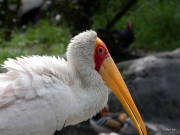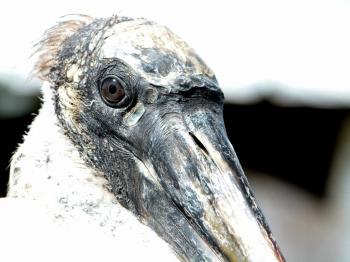
Wood Stork by Dan at Lake Morton Jan 2011
Dan and I were out birdwatching this last week several times. We have the privilege of seeing the Wood Storks quite frequently. The Birds of the Bible – Stork and the Birds of the Bible – Stork II articles have covered different aspects of the Stork. This time, the Bible passage in Job 39:13 is going to be covered.
The wings of the ostrich wave proudly, But are her wings and pinions like the kindly stork’s? (Job 39:13 NKJV)
The idea of the verse is that the Ostrich waves or flaps her wings proudly, but she lacks several things that the Stork has like the feathers and wings of a stork and nor the care for her young as the Stork show its young.
God has created them both, but they do not behave the same. Each has it’s own design and place to fill.

Lee feeding Wood Stork at Lake Morton by Dan Jan 2011
What is interesting is the different translations of Job 39:13. I use the e-Sword Bible program and have loaded every one of the free (English) Bibles and also have the New American Standard Bible and New King James Versions installed, which we purchased. One of the neat things you can do is select a verse and then choose “Compare” and every one of the Bible versions of that verse shows. It never ceases to amaze me that the versions can vary some times so much. This is one of those verses. (If you haven’t tried out the e-Sword Bible, it is worth loading and using and it is free for most of it. They also have the Bible in different languages.)
For now, I am going to show some of the versions that show the Stork:
(Brenton) The peacock has a beautiful wing: if the stork and the ostrich conceive, it is worthy of notice,
(Darby) The wing of the ostrich beats joyously–But is it the stork’s pinion and plumage?
(ERV) “An ostrich gets excited and flaps its wings, but it cannot fly. Its wings and feathers are not like the wings of a stork.
(GNB) How fast the wings of an ostrich beat! But no ostrich can fly like a stork.
(JPS) The wing of the ostrich beateth joyously; but are her pinions and feathers the kindly stork’s?
(LITV) The wing of the ostriches flap joyously, though not like the stork’s pinions for flight.
(MKJV) The wing of the ostrich beats joyously; though not like the stork’s pinions for flight.
(NKJV) “The wings of the ostrich wave proudly, But are her wings and pinions like the kindly stork’s?

Storks Shadowing Baby in Lakeland by Dan
Some of the other versions either mention a hawk, heron, or just the pinion and plumage of love. Ostriches are known for abandoning their young (Job 39:13-18 Birds of the Bible – Ostrich I) and the Storks are protective of their young (Stork II). The Ostriches don’t fly particularly, but the Storks have great wings and migrate good distances (Stork II).
Here are some facts about the Storks wings from various books and internet sites:
“Stork’s wings are built in a way, which allows them to take advantage of the streams of upward moving air. They are long and, compared to other birds, very wide – similar to these of vultures, condors, pelicans and the closest relatives of storks. Large wings of a stork “catch” the up going streams of air. Storks travel like gliders, taking advantage of the air movement.”

White Stork (Ciconia ciconia) by Nikhil Devasar
“Storks tend to use soaring, gliding flight, which conserves energy. Soaring requires thermal air currents. Ottomar Anschütz’s famous 1884 album of photographs of storks inspired the design of Otto Lilienthal’s experimental Gliders of the late 19th century. Storks are heavy, with wide wingspans: the Marabou Stork, with a wingspan of 3.2 m (10.5 ft), joins the Andean Condor in having the widest wingspan of all living land birds.” (Wikipedia)
“White Storks rely on the uplift of air thermals for long distance flight, taking great advantage of them during annual migrations between Europe and Sub-Saharan Africa. The shortest route south would take them over the Mediterranean, but since thermals only form over land, storks take a detour and avoid long water crossings. It has been estimated that storks metabolize the same amount of body fat to travel a distance in flapping flight as 23 times further by soaring, so they usually avoid prolonged wing flapping flight. Long flights over water may occasionally be undertaken. ”
To facilitate the sea crossing, birds from central Europe can take an eastern migration corridor, crossing the straits of Bosphorus to Turkey, traversing the Levant, and then bypassing the Sahara Desert by following the Nile, or follow a western route over the straits of Gibraltar. These corridors maximize the help from the thermals and thus save energy. The eastern route is by far the more important, with 530,000 birds taking this crossing, making this stork the second commonest migrant after the Honey Buzzard. The flocks of raptors, storks and Great White Pelicans can stretch for 200 km (125 mi). The eastern route is twice as long as the western, but storks take the same time to reach the wintering grounds by either route. Juvenile storks set of on their first southward migration in an inherited direction, but if displaced from that bearing by weather conditions, they are unable to compensate, and may end up in a new wintering location. Adults can compensate for strong winds and adjust their direction to finish at their normal winter sites, because they are familiar with the location. For the same reason, all spring migrants, even those from displaced wintering locations, can find their way back to the traditional breeding sites. Once in Africa, the storks spend the winter in savanna from Kenya and Uganda south to the Cape Province of South Africa. In these areas they congregate in large flocks which may reach a thousand individuals or more.” (Wikipedia)

Woolly-necked Stork (Ciconia episcopus) by Nikhil Devasar
(From Matthew Henry’s Commentary) – “Job 39:13-18
The ostrich is a wonderful animal, a very large bird, but it never flies. Some have called it a winged camel. God here gives an account of it, and observes,
I. Something that it has in common with the peacock, that is, beautiful feathers (Job_39:13): Gavest thou proud wings unto the peacocks? so some read it. Fine feathers make proud birds. The peacock is an emblem of pride; when he struts, and shows his fine feathers, Solomon in all his glory is not arrayed like him. The ostrich too has goodly feathers, and yet is a foolish bird; for wisdom does not always go along with beauty and gaiety. Other birds do not envy the peacock or the ostrich their gaudy colours, nor complain for want of them; why then should we repine if we see others wear better clothes than we can afford to wear? God gives his gifts variously, and those gifts are not always the most valuable that make the finest show. Who would not rather have the voice of the nightingale than the tail of the peacock, the eye of the eagle and her soaring wing, and the natural affection of the stork, than the beautiful wings and feathers of the ostrich, which can never rise above the earth, and is without natural affection?
Storks are in the Ciconiidae Family (slideshow) and there are 19 species of them around the world. The Storks are the only family in the Ciconiiformes Order. See the Storks Page.
*










































